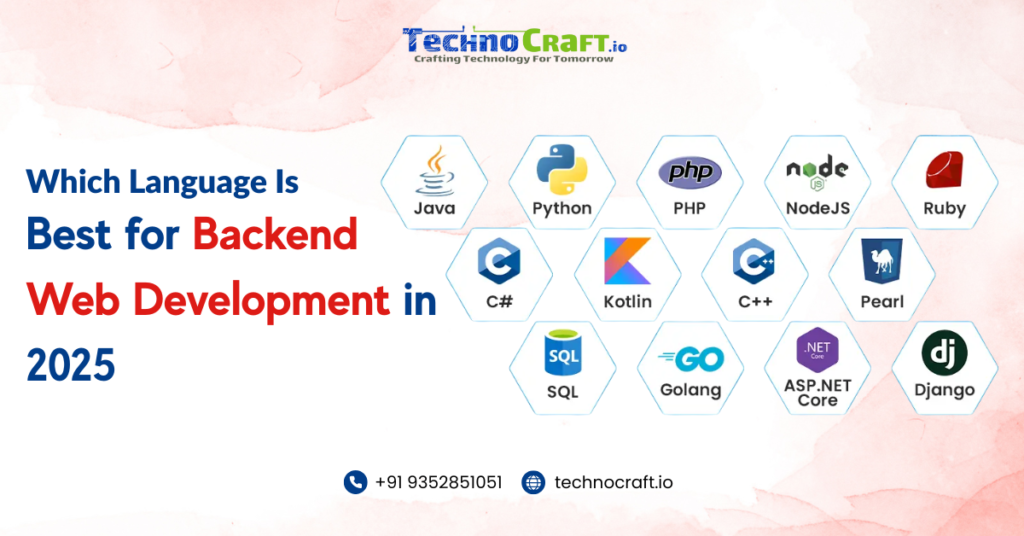Backend web development is like the engine room of a website or app. It’s where all the logic, database interactions, server operations, and APIs live. While users only see the frontend, the backend is the magic that makes everything run smoothly.
But here’s the million-dollar question: Which language is the best for backend web development in 2025? With so many options and tech constantly evolving, it’s important to make the right call—whether you’re building an eCommerce site, real-time chat app, or an enterprise platform.
The Evolving Landscape of Backend Development
2025 isn’t just about writing code. It’s about writing smart, scalable, and efficient code. Backend development today revolves around cloud-native architectures, microservices, containerization, and server less environments. Languages that can keep up with this pace—those that offer flexibility, performance, and scalability—are leading the charge.
Top Languages for Backend Development in 2025
Here’s a look at the top players in the backend world and what makes each of them tick.
Node.js – The JavaScript Powerhouse
Node.js backend development is booming—and for good reason.
- It’s asynchronous and event-driven, perfect for building fast, real-time apps like chats, games, and collaboration tools.
- With JavaScript across the stack, devs love that they don’t need to switch languages between frontend and backend.
- The npm ecosystem offers a treasure trove of packages that make development lightning fast.
- Frameworks like Express and NestJS bring structure and scalability.
Why pick Node.js in 2025? Because it’s everywhere—from startups to big tech—and it’s not slowing down.
Python – Simplicity Meets Power
Python is known for its clean syntax and readability, making it a go-to for rapid development.
- Used heavily in AI, machine learning, and data science, Python also shines in backend development through frameworks like Django and Flask.
- It’s great for building RESTful APIs, web apps, and even lightweight microservices.
- Its rich ecosystem makes it easy to connect with databases, handle authentication, and build scalable architectures.
If you’re into data-heavy apps or want fast development cycles, Python’s your best friend.
Go (Golang) – The Performance Beast
Go, developed by Google, is all about speed and simplicity.
- Its built-in concurrency support means it handles multiple processes effortlessly—perfect for modern distributed systems.
- It’s statically typed, compiles fast, and produces highly efficient executables.
- Go is ideal for cloud applications, microservices, and performance-critical APIs.
In 2025, Go is rising fast as a backend favorite, especially in performance-hungry environments.
Java – The Corporate Giant
Still standing strong, Java is the go-to for large-scale enterprise applications.
- It’s known for scalability, robustness, and long-term maintainability.
- Frameworks like Spring Boot make Java backend development modern and enjoyable.
- Its huge ecosystem and mature tools make it a safe bet for banking, finance, and high-security applications.
If you’re building something big and need bulletproof stability, Java is worth considering.
Ruby – Developer’s Delight
Ruby on Rails was the darling of web dev in the 2010s—and while its popularity has dipped, it still holds value.
- Developers love Ruby for its expressive syntax and developer happiness.
- Rapid prototyping and convention-over-configuration make it a strong choice for startups.
In 2025, Ruby isn’t mainstream, but it’s still solid for MVPs and internal tools.
Key Factors to Consider While Choosing a Backend Language
Project Requirements
Are you building a real-time app? Go with Node.js. Need complex business logic and structure? Java might be your jam.
Developer Skill Set
Don’t reinvent the wheel. If your team knows Python inside-out, it makes sense to build on that.
Community Support and Libraries
The bigger the community, the more resources and libraries you have at your fingertips. Node.js and Python both score high here.
Scalability and Performance
Go and Java win when it comes to handling traffic spikes and complex processes.
Security
All major languages offer security tools, but Java and Python have robust, enterprise-ready solutions.
Node.js Backend Development – A Closer Look
Node.js deserves special mention in 2025. Here’s why it’s leading the charge:
Event-Driven Architecture
Perfect for real-time apps, Node.js processes thousands of requests without blinking.
One Language, Full Stack
Write JavaScript everywhere. It cuts dev time and reduces complexity.
Popular Frameworks
Frameworks like Express.js, NestJS, and Fastify make building large-scale apps easier and more organized.
Final Thoughts – Which Should You Pick?
There’s no one-size-fits-all answer. But here’s a quick rundown:
- Choose Node.js for real-time, scalable apps.
- Pick Python for clean code and data-driven apps.
- Go with Go if performance is top priority.
- Java is great for big, enterprise systems.
- Ruby is still good for quick MVPs.
Whatever you pick, focus on clean code, scalability, and long-term support.
Conclusion
Backend web development in 2025 is dynamic, exciting, and full of potential. Whether you’re building with Node.js, Python, or Go, make sure your tech choice aligns with your goals. Backend development isn’t just about code—it’s about building a system that grows with you.
So—which language will power your next big idea?
Start building smarter today!
FAQs
1. What is the most beginner-friendly backend language?
Python is often recommended for beginners due to its easy syntax and wide usage.
2. Is Node.js still in demand in 2025?
Absolutely. Node.js backend development remains highly relevant due to its speed, flexibility, and full-stack JavaScript ecosystem.
3. Can Python handle large-scale web apps?
Yes, with frameworks like Django and tools like Celery and Redis, Python can power large and complex applications.
4. Is Go better than Node.js?
Go is faster and better for concurrency, but Node.js is more flexible for web apps and has a larger ecosystem. It depends on your project needs.
5. Which language is best for microservices?
Node.js, Go, and Java are all solid choices for microservices due to their performance and modularity.



